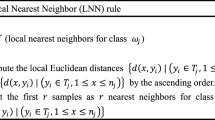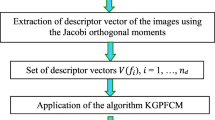Abstract
In this paper, we propose a novel classification algorithm, called geometrical probability covering (GPC) algorithm, to improve classification ability. On the basis of geometrical properties of data, the proposed algorithm first forms extended prototypes through computing means of any two prototypes in the same class. Then Gaussian kernel is employed for covering the geometrical structure of data and used as a local probability measurement. By computing the sum of the probabilities that a new sample to be classified to the set of prototypes and extended prototypes, the classified criterion based on the global probability measurement is achieved. The proposed GPC algorithm is simple but powerful, especially, when training samples are sparse and small size. Experiments on several databases show that the proposed algorithm is promising. Also, we explore other potential applications such as outlier removal with the proposed GPC algorithm.
Preview
Unable to display preview. Download preview PDF.
Similar content being viewed by others
References
Duda, R.O., Hart, P.E., Stork, D.G.: Pattern Classification, 2nd edn. John Wiley & Sons, Chichester (2001)
Cover, T.M., Hart, P.E.: Nearest neighbor pattern classification. IEEE Transactions on Infomation Theory 13, 21–27 (1968)
Dasarathy, B.V. (ed.): Nearest Neighbor (NN) Norms: NN Pattern Classification Techniques. IEEE Computer Society, Washington (1991)
Li, S.Z., Chan, K.L., Wang, C.L.: Performance Evaluation of the Nearest Feature Line Method in Image Classification and Retrieval. IEEE Transactions on Pattern Analysis and Machine Intelligence 22(11), 1335–1339 (2000)
Fraley, C., Raftery, A.E.: Model-based Clustering, Discriminant Analysis, and Density Estimation. Technical Report No. 380, University of Washington (2000)
Dempster, A., Laird, N., Rubin, D.: Maximum likelihood from incomplete data via the EM algorithm. J. Roy. Statist. Soc. B 39, 1–38 (1977)
Samaria, F.S.: Face Recognition Using Hidden Markov Models. PhD thesis, University of Cambridge (1994)
Graham, D.B., Allinson, N.M.: Characterizing virtual Eigensignatures for General Purpose Face Recognition. In: Wechsler, H., Phillips, P.J., Bruce, V.F., Fogelman-Soulie, V., Huang, T.S. (eds.) Face Recognition: From Theory to Applications. NATO ASI Series F, Computer and Systems Sciences, vol. 163, pp. 446–456 (1998)
Michael, J.L., Budynek, J., Akamatsu, S.: Automatic classification of Single Facial Images. IEEE Transactions on Pattern Analysis and Machine Intelligence 21(12), 1357–1362 (1999)
Murphy, P.M., Aha, D.W.: UCI Repository of machine learning databases. Department of Information and Computer Science. University of California, Irvine (1994), http://www.ics.uci.edu/~mlearn/MLRepository.html
Daniel, L.S., Weng, J.: Using Discriminant Eigenfeatures for Image Retrieval. IEEE Transactions on Pattern Analysis and Machine Intelligences 18(8), 831–836 (1996)
Turk, M., Pentland, A.: Eigenfaces for Recognition. Journal of Cognitive Neuroscience 3(1), 71–86 (1991)
Roweis, S.T., Lawrance, K.S.: Nonlinear Dimensionality reduction by locally linear embedding. Science 290, 2323–2326 (2000)
Zhang, J., Shen, H., Zhou, Z.-H.: Unified Locally Linear Embedding and Linear Discriminant Analysis Algorithm (ULLELDA) for Face Recognition. In: Li, S.Z., Lai, J., Tan, T., Feng, G., Wang, Y. (eds.) SINOBIOMETRICS 2004. LNCS, vol. 3338, pp. 209–307. Springer, Heidelberg (2004)
Zhang, J., Li, S.Z., Wang, J.: Nearest Manifold Approach for Face Recognition. In: The 6th IEEE International Conference on Automatic Face and Gesture Recogntion, Seoul, Korea (May 2004)
Zhang, J., Li, S.Z., Wang, J.: Manifold Learning and Applications in Recognition. In: Tan, Y.P., Yap, K.H., Wang, L. (eds.) Intelligent Multimedia Processing with Soft Computing, Springer, Heidelberg (2004)
Author information
Authors and Affiliations
Editor information
Editors and Affiliations
Rights and permissions
Copyright information
© 2005 Springer-Verlag Berlin Heidelberg
About this paper
Cite this paper
Zhang, J., Li, S.Z., Wang, J. (2005). Geometrical Probability Covering Algorithm. In: Wang, L., Jin, Y. (eds) Fuzzy Systems and Knowledge Discovery. FSKD 2005. Lecture Notes in Computer Science(), vol 3613. Springer, Berlin, Heidelberg. https://doi.org/10.1007/11539506_29
Download citation
DOI: https://doi.org/10.1007/11539506_29
Publisher Name: Springer, Berlin, Heidelberg
Print ISBN: 978-3-540-28312-6
Online ISBN: 978-3-540-31830-9
eBook Packages: Computer ScienceComputer Science (R0)




